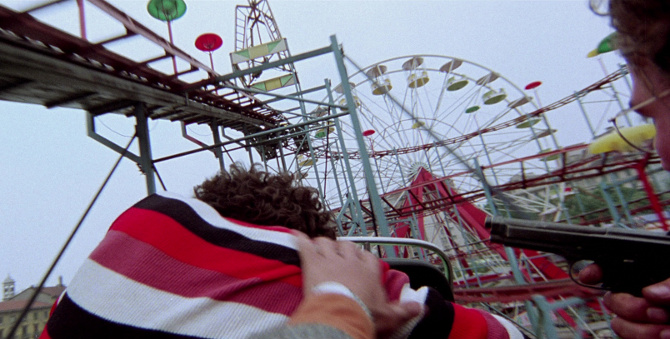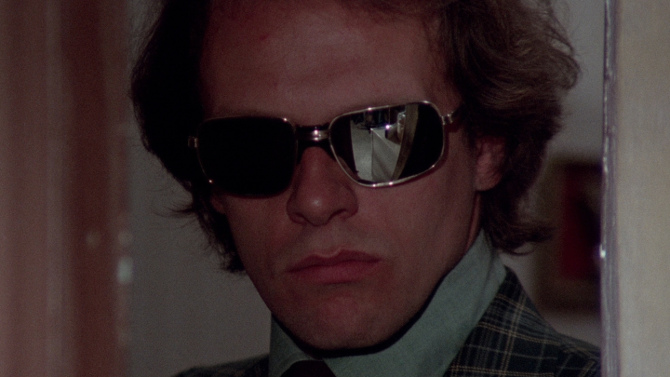Combining two of the most fascinating Italian genres of the 1970s, giallo and poliziotteschi (that is, thriller and crime/action), 1975’s The Suspicious Death of a Minor (also known as Too Young to Die) uses more subtle strokes of violence and nudity compared to many other giallo features from the time, instead building suspense and energy by way of highly original set pieces.
Directed by Sergio Martino (this is his sixth and final giallo, another example being Your Vice Is a Locked Room and Only I Have the Key), he introduces us to the picturesque yet dangerous world of Milan, circa 1975 – a place where we find a young prostitute named Marisa (Patrizia Castaldi) on the run from an unsettling figure in mirrored glasses. Attempting to meet with undercover detective, Paolo Germi (Claudio Cassinelli – the actor sadly died in a helicopter crash while filming another Martino picture – 1986’s Hands of Steel), she is eliminated by the stone cold proficient assassin before being able to pass on any actionable information.
Investigating a world of underage prostitution, drugs and shady money transactions, his snooping ways draw the ire of the mysterious foes he is attempting to bring down. He is thankfully supported by the understanding Police Superintendent (Mel Ferrer), as several other bumbling detectives think less highly of his controversial methods.
Recruiting street level petty thief Giannino (Adolfo Caruso) as his right hand man (an apt title, as he is a very talented pickpocket), the pair delve deeper into the seedy Milano underworld – often in plain site, seemingly reputable businesses like a babysitting procurement office having a much different modus operandi. Will Paolo be able to uproot the deep-seeded criminal organization, or will his dangerous undercover work catch up with him?
Though not the most twisty, gore filled example of a giallo movie (a few storytelling flaws make things unclear at the beginning), Martino utilizes superb locations and richly designed set pieces to amaze. Something perhaps never to be seen again on film, Paolo gets into a shootout with a thug on a double-car roller coaster – it fusing suspenseful action with an almost Naked Gun-style absurdness. Another moment is the comedic leaning car chase, mini clunker automobiles flying through the busy streets of Milan – car doors being removed and thrown, a man’s bicycle hit and turned into a unicycle, as well as an elderly man forced to fall like a break dancer to avoid injury, just three examples of its differences from more traditional American fare. On the more serious side, Paolo trails the shaded hitman from inside a matinée playing movie theatre all the way up onto the varied rooftops above – the cinema has a retractable roof designed to open for airflow on those sweltering hot Italian evening screenings (as you will probably guess, it comes into play); while another thrilling locale is the nearly pitch black train tunnel – the locomotive carries cars back and forth between Italy and Switzerland.
This is not to say that there are no visible giallo moments to be found. . . visual splendour is evident in how Martino builds to the conclusion of many of his episodic vignettes. Perhaps the most impressive piece of film making: a back is seen, the camera peering between it and the body’s arm to a blood red door in the distance; cutting to the door’s lion head knocker, it slowly creaks open; next, we see the stairs through the wrought iron spindles, the still unknown person’s feet carefully making their way up each step; a gun is then drawn, which is followed by a first person perspective view of the figure walking towards a door. . . I will end here so as not to ruin the beautifully executed moment. Another very giallo touch finds a prostitute in the sights of the aforementioned killer. . . the action unfolding in the kitchen, your imagination can attempt to guess the outcome until you watch this one.
Falling somewhere between suspense thriller, action crime feature and comedy, The Suspicious Death of a Minor capitalizes on the authenticity of its tale – as there was indeed rampant corruption found in Italy at the time. Though definitely not a masterpiece of giallo by any means, it succeeds much more often than it fails, its style and creativity evident in each and every frame. Finally, glasses must be mentioned once again, as both the protagonist and killer wear them – the detective’s, which are often broken, are symbolic of his difficulty in cracking the complex case, while the assassin’s reflective pair hide the eyes of a sadistic murderer, the lenses mirroring what he is seeing. So, make sure to add this one to your bank of must watch movies, it is well worth delving into.
This film is in Italian with English subtitles



